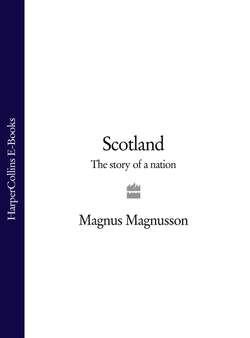Читать книгу Scotland: The Story of a Nation - Magnus Magnusson - Страница 10
The first people in Scotland (c.7000 BC)
ОглавлениеOne day in the early 1980s a ploughman was working on a potato field near the village of Kinloch, at the head of Loch Scresort on the island of Rum in the Inner Hebrides. As his ploughshare turned over the soil, he caught sight of a beautiful barbed and tanged stone arrowhead. He reported the find at once, and in 1984–85 archaeologist Caroline Wickham-Jones conducted an excavation of the area on behalf of Historic Scotland. What she unearthed was the earliest human settlement site yet discovered in Scotland, dating from the Mesolithic (Middle Stone Age) period, nearly nine thousand years ago.
It was a large camp-site rather than a formal settlement: arcs of stake-holes indicated the locations of several shelters, and there were many traces of fires and broken hearth-stones as well as numerous pits and hollows. These first ‘Scots’ had built small tent-like shelters out of wood, brushwood and skins; they made hearths on which they could prepare food and even smoke meat and fish to keep for the winter. The climate at that time was moist and relatively warm – perhaps 2°C warmer than today; much of the island was covered by open heathlands with shrubs of juniper and bog myrtle, but there was also light, low-canopied woodland, while copses of birch and hazel flourished in the more sheltered areas. Remains of carbonised hazelnut shells showed that nuts were an important part of the early inhabitants’ diet.
The most significant find at Kinloch was the discovery of an assemblage of more than 140,000 stone tools and discarded flint-like material. The Mesolithic dwellers on Rum had made a variety of tools from stone, including microlithic (‘small stone’) arrowheads, scrapers, awls, blades and flakes. They used flint which they collected as pebbles from the beaches; but they also had access to a good knapping stone known as bloodstone, which has similar properties to flint. The source of the Rum bloodstone was on the west coast of the island, ten kilometres from the Kinloch settlement: Bloodstone Hill (Creag nan Steàrnan).
Good-quality stone for tools is rare in Scotland, and the presence of bloodstone made Rum very special to the early inhabitants of the western seaboard; we know from archaeological sites elsewhere that people from many of the surrounding islands and the adjoining mainland used bloodstone from Rum for their tools.
Such were the first known inhabitants of prehistoric Scotland. They had moved up from the south (i.e. England) soon after the end of the last Ice Age, ten thousand years ago, during the Mesolithic period. This sounds very ancient indeed, but it is worth remembering that hunter-gatherers had been living in England for at least four thousand years before that; and in the much warmer climate of the Middle East, people were already living in cities and experimenting with woollen textiles, metal-working, pottery and the irrigation of farmlands.
The Mesolithic incomers to Scotland were not ‘settlers’, as such. They were small family groups or communities of nomadic people who lived by hunting, fishing and gathering plants; they would establish camps where they could spend the winter and then make forays in pursuit of deer herds in the spring and summer. They made tools and weapons of stone, they used fire for cooking and warmth, and they dressed in animal skins. They were mobile on both land and sea, and soon established barter-links with other semi-permanent communities.
It is impossible to say how large the Mesolithic population of Scotland was, but several sites have already been identified at places like Morton on Tentsmuir, north of St Andrews and at various other places from Grampian to Argyll.
The Mesolithic period in Scotland lasted for about four thousand years, and merged into the Neolithic (New Stone Age) period around 3000 BC. By then the last land-link between south-east England and the Continent was submerged, and Britain had become an island. This change had involved an influx of new people from the south, people who started to clear the forests and farm the land. There were now permanent communities, such as the marvellous Neolithic village of Skara Brae, on Orkney.
